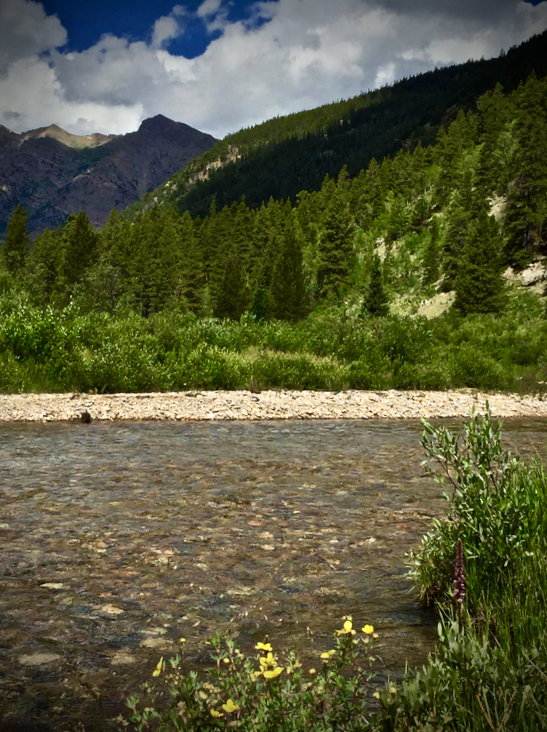Photo by Rachel Andona
By Chris Hunt
We steered the rig into a pull-off shaded by lodgepoles and pressed almost flat by frequent use. Nothing remained of the understory—every fallen log, limb or twig had been meticulously collected for firewood. Even the lodgepoles were nude from the ground up, only sporting branches starting a good seven feet from where the trunk met the black earth.
That’s where campers give up, I guess.
Of course, they could wander a bit further and come back to camp with plenty of burnable tinder and a few logs to boot, but when it’s just as easy to buy a split log or two at the convenience store in Leadville, why make the effort?
It hurt a bit, honestly, to see this sacred place largely denuded from the ground up just to make a campfire. Or a decade’s worth of fires. It had been that long since I’d been back to this place where my brothers and I literally grew up. This was the first place we ever camped by ourselves. This creek held the trout we chased as kids, and again as teens and yet again as we grew up, got married, had kids of our own and … well, not every story ends well.
The upper Arkansas Valley is just close enough to Denver and its sprawling masses as to be convenient for weekend campers. Any farther and it’s not worth the drive on Friday just to fight the traffic back to the city on Sunday. Got a long weekend? It’s the perfect spot, at the foot of some of the highest peaks in the Lower 48 and lined by an honest-to-God trout stream.
It was early on a Friday as we pulled off the pavement just south of Leadville and wandered off onto a gravel road leading west toward snow-lined peaks, even in late July. As we left the private land and motored onto the San Isabel National Forest, I looked at Rachel and made a quick observation.
“I’ve never seen this many people here in my life. Ever.”
Indeed, every campsite, managed or otherwise, was occupied. Every pull-off was crowded by a car, sometimes two. Every parking lot at every trailhead was overflowing. Even the old clearcut that nuked a lodgepole forest into … well… a clearcut, way back when I was a kid, was a stump-marred RV playground, complete with signs scrawled onto paper plates denoting the “Draper wedding” or the “Smith reunion.”
While it’s easy to bemoan the overuse, I had to remind myself of one thing. This is exactly what this land is for, and its owners were happily enjoying it. The RVs, the ATVs, the Jeeps and SUVs like mine were all part of that secret sauce that reminds lawmakers and federal land managers that front-country destinations like this have a huge appeal to the masses.
And, that’s even if the masses likely don’t even know their public lands birthright is still under attack by state and federal lawmakers who have been trying for years to transfer their ownership from the American people to state governments, or, without all the political camouflage, to simply sell these lands outright, to the highest bidders.
We passed the low-country (and, at well over 10,000 feet in elevation, I use that term lightly) camping area and motored past the sign that warns motorists that the road ahead is a rough one, for high-clearance vehicles only. I figured this would thin the crowds a bit, and I was right. We did see some Jeepers and shared the single-track road with ATVs and such, but when we stopped to string up our fly rods and walked away from the road, we were alone.
And, once we stepped off the manicured grounds of the pioneered campsite, the creek I fished as a kid was still largely the same. Interrupted now and then by beavers—just as it had been all those years ago—it meandered down as pretty a mountain valley as you can imagine. The invasive brook trout from all those years ago are still there, and Rachel was able to find a nice foot-long brown to make the day even better.
There’s comfort in “place.” As much as this place, which belongs to some 320 million Americans as much as it does to me, can be “home,” that’s exactly what it is. My grandfathers introduced me to it, and my kids have wet lines and yanked brookies from this meadow. Generations to follow will, too, if we can keep it ours. I can live without readily available downed timber for campfires (or I’ll just walk a little farther), so long as it stays under common ownership and doesn’t fall into the hands of someone who might choose to lock us all out.
As we drove down off the hill and through the sea of campers and riders, I realized that this place was “home” to these folks, too. This may be as wild a place as they see all year—maybe they take the kids camping once or twice a summer, or this is a place that’s special enough to some to invite the whole family up for a wedding or a reunion.
I’ll share my home with them, and millions more. It’s ours, after all.
Chris Hunt is the national editorial director for Trout Media. He lives and works in Idaho Falls, Idaho.



